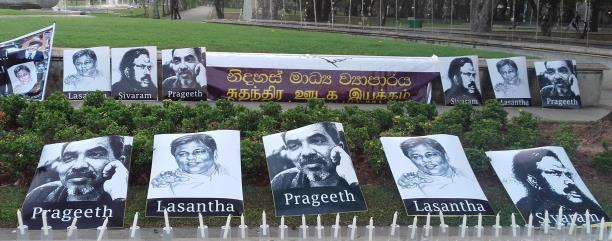( Press release/ Amnesty International)
Ten years ago, Tamil journalist Subramaniyam Sugitharajah, took photos of the bodies of five Tamil students who were murdered by the Sri Lankan army on 2 January 2006, in Trincomalee.1 The photos, which were published in his newspaper Sudar Oli, suggested that the students had been killed by gunshot wounds execution-style – rather than by a self-detonated grenade – which is what the army initially claimed.
Just weeks later, on 24 January 2006, Sugitharajah was shot and killed on his way to work. His killer was never identified.2
Sugitharajah’s case is just one example of the scores of attacks against journalists in Sri Lanka in the past decade. A recent list compiled by media NGOs details 44 media workers who have been murdered since 2004.3
January is a month of remembrance for many of the families and friends of journalists, as it marks a time when many of them were killed or disappeared. Television producer Lal Hemantha Mawalage was stabbed in January 2008.4 Lasantha Wickramatunga, editor of Sunday Leader, was killed on his way to work in January 2009. 5 Prageeth Eknaligoda, a political cartoonist and journalist for Lanka-e-news, was subjected to enforced disappearance in January 2010 after writing an article highlighting growing support for an opposition party candidate. In Colombo, candle-lit ‘Black January’ vigils are held annually to commemorate those who have been threatened or attacked because of their writing.
Since the election of President Maithripala Sirisena in January 2015, Sri Lanka has shown a new willingness to acknowledge past abuses and commit to reforms, including making promises to combat the culture of impunity for threats and attacks on media workers. Websites banned under the Rajapaksa regime have been unblocked; journalists in exile have been invited to return; and promises have been made to reopen files of missing and killed journalists.
However, very few people have actually been investigated, prosecuted or held accountable for threats and attacks on journalists. In Pragreeth’s case, after five years of inaction, in August 2015, the Sri Lankan authorities arrested several individuals for questioning. Yet allegations remain of military interference stalling progress in the case. Just this week a controversial Buddhist monk Galagodaaththe Gnanasara Thera disrupted court proceedings in Prageeth’s case in the Homagama magistrate’s court and allegedly threatened his wife, Sandya Ekneligoda.
Until the Sri Lankan government turns words into action, a culture of impunity for attacks and enforced disappearances of media workers will remain.
Words must be turned into action.
When the Sri Lankan government co-sponsored Resolution 30/1, ‘Promoting Reconciliation, Accountability and Human Rights in Sri Lanka’, at the 30th Session of the Human Rights Council in September 2015, it showed a renewed inclination to create a more enabling environment for human rights and provide truth and justice to victims of human rights violations. Paragraph 11 specifically encourages the Government of Sri Lanka to investigate all alleged attacks by individuals and groups on journalists … to hold perpetrators of such attacks to account and to take steps to prevent such attacks in the future.6
Amnesty International calls on the Sri Lankan Government to take substantive and concrete steps in heed of the resolution they co-sponsored, and the promises both the President and Prime Minister have made, to expand media freedoms and tackle the climate of impunity by:
Carrying out impartial, independent and effective investigations into the threats, attacks and murders of journalists and human rights activists;
Unconditionally condemning the attacks against journalists and media workers;
Ensuring the court proceedings in Prageeth Ekneligoda’s case continue without obstruction;
Ensuring the safety of Mrs Sandya Ekneligoda and all other families seeking truth and justice for their loved ones.
1 https://www.amnesty.org/en/latest/campaigns/2013/08/they-killed-my-son/ (Accessed 19 January 2016).
2 http://www.refworld.org/cgi-bin/texis/vtx/rwmain?docid=47c567442 (Accessed 19 January 2016).
3 http://www.sundaytimes.lk/151213/news/compensation-soon-for-44-slain-media-persons-pm-175058.html (Accessed 26 January 2016)
4 https://www.amnesty.org/en/latest/news/2008/02/journalists-danger-sri-lanka-20080205/ (Accessed 26 January 2016).
5 https://www.amnesty.org.uk/press-releases/sri-lanka-
